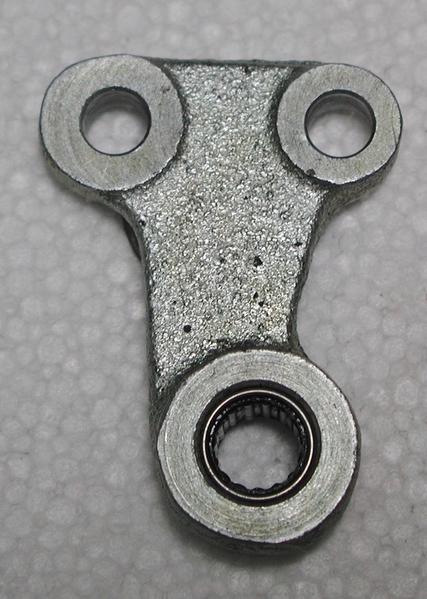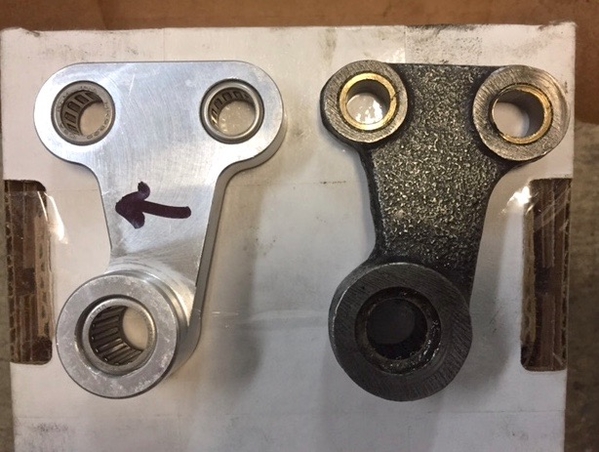My 74 Pantera clutch pedal is getting stiffer as I age. It has the Factory reduction set up now. How can I make it softer yet? It makes my knee hurt as I drive it.
Replies sorted oldest to newest
Mine was doing the same. It got much better after I lubricated all the joints in the linkage under the dashboard. Worth a try!
Clutch effort & available clutch release travel have been issues since the first Pantera hit the road.
Lubricating the clutch pedal assembly is a definite first thing to try. If that's not enough, here's two ideas:
The hydraulic throw-out bearing sold by Pantera Performance Center reduces effort, as per one reliable source. And it improves the amount of travel available too. Perhaps others could chime-in on that.
And of course, diaphragm clutches are "supposed" to reduce effort too. What do you say guys, do they help?
Thanks Guys,
I will try the lube route first. Has anybody heard of putting a larger bore slave cylinder in?
The original (and some aftermarket) effort reduction bell cranks did not have bearings in two of the three holes. Not having bearings at those pivot points creates additional friction and increases pedal effort. If not frequently lubricated, the holes become elongated and / or the pivot pins become worn. This wear has a net effect of reducing the throwout bearing's travel, which is not a good thing in our Panteras.
Here is a pic of a stock (factory) bell crank. Note that there are no bearings in the top two holes. This bell crank is not hardened and can easily be machined.
The bell crank on the left was purchased from one of the Pantera vendors, and it has bearings in all of the holes. The bell crank on the right is a stock unit that someone had added bushings to the top two holes. Note that the top right bushing is badly worn on its left side.
I replaced the stock bell crank in a friend's Pantera with a full bearing aftermarket unit, and there was a noticeable reduction in clutch pedal effort. YMMV
John
Attachments
Increasing the slave cylinder's bore would definitely reduce clutch pedal effort, BUT, the clutch pedal's travel would also need to be increased in order to have the same (stock) throwout arm travel.
John
Thanks John,
That is very helpful, I will look into that situation.
If none of the above works, knock the pressure plate out of it. You can have it out in less than half day. No need to remove the lid. Take it to a re-builder, tell them you're not interested in a 23, 25, or 28 hundred or even 3000 lb force plate springs. I can build one with 1800-2200 that works smooth as jelly & handle normal horse power. We've taken these plates out what have 3200 and MORE lb springs. Ridiculous.
Pantera Miami
Further, with respect to diaphragm plates, like Center Force, here's what to expect: Higher initial pedal effort, then it turns soft having a palatable pedal effort. In other words, little harder initially, then voom goes down easily.
Some months ago, Summit & Jegs no longer provide Heyes clutch parts. Back order after back order. I called Heyes directly. They can no longer have the 'fingers' made. So...simply send your three finger to them for rebuild. Cost? Much cheaper than buying a new clutch pack. Send you disc too for reline.
Want to spend even less, send yours to a local rebuilder. You'll pay 125 to reline the disk, 175 to respring/surface your own p/plate. Plus, you know already it will fit & work.
We do a ton of them.
Pantera Miami
Sharkey,
That is alot of useful info. Sounds like you have been down that road numerous times.
Thank You Very Much.
Don't forget to lube the pivots at the slave linkage @clutcharm in case it wasn't mentioned.
I suffered from the worn bellcrank issue detailed by John earlier in this thread. Because the wear occurs so slowly, you may not notice when it's occurring.
I have a McLeod hydraulic T/O bearing and, as George mentioned, it significantly reduces pedal effort. Mine's been 100% reliable but others have found them to be a giant maintenance headache, so I hesitate to recommend them.
Years ago, in a P.I. magazine, there was an article by a guy who installed a Mitsubishi 3000GT power clutch booster in his Pantera. It worked just like a power brake booster. If I recall, he was installing a hand operated clutch mechanism and needed to decrease clutch effort by a significant amount. I don't recall the issue but someone else might. All I remember is, it was during the Adler era.
I have a brand new Centerforce pressure plate & dual friction disk for sale. Disc is for a ZF-1 spline but I believe the pressure plates will work for the ZF-2 if interested PM me. Requires a centerforce flywheel.
You could fit at vacuum powered booster to greatly reduce pedal effort like many owners of older Land Rovers do for instance. Of course the engine needs to run for it to operate exactly as it is for your brake booster.
I've seen diaphragm clutches in a Pantera that could be pushed in by hand, and held a near-stock 351-C while not slipping. They do reduce pedal effort , but if you want to do it right, there are two basic kinds. Type 1 has straight fingers- ref. stock early Chevy clutches. Type 2 has an angle bent into the finger ends where the throwout bearing rides. The 'bent' finger-tips are thus more horizontal. Geometry is such that a flat-face throwout bearing on a straight-finger clutch may give a stepwise feel in the pedal to sensitive drivers. Type 1 clutch plates require a crowned GM-style throwout bearing to avoid a non-linear feel. They might not fit a Cleveland bearing carrier. Type 2 clutches use a flat-face throwout on bent fingers & no odd feeling. A stock Long 3-finger clutch avoids all this by using replaceable crowned screws on the lever tips with a flat-face bearing.
As Sharky said, one big problem with shops is, too many see a Pantera and instantly think "racecar" so you get a clutch good for 1000+ hp! Be careful of Centerforce clutches; they sell a heavy-duty diaphragm type 2 clutch that is rated at 3200 lbs pedal force and in use, will stress every part of your body, not to mention your car! No fun at all in traffic. Centerforce also use longer, one-size-larger gr-8 clutch bolts than stock, with short stand-offs. So you cannot add them to your existing flywheel. This markedly increases the cost. And with aftermarket clutches of any brand (E-Bay?), they also may not use a Ford bolt pattern (or bolt size) in a flywheel. Centerforce makes good units but ultimately kind of pricy.
Jb1490 Nothing a little Jbweld can't handle LOL.
Ya know, if filled with JB weld and machined for a roller or bronze bearing I bet it could live again.
🤔
Larry
Bosswrench,
What route should I take to make it as simple as possible ?
Find McLeod Pressure plate 360505, disc 260131 & be done with it. If you can't locate, send units for rebuild. Two day turn-around.







